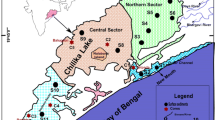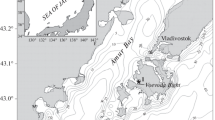Abstract
The contents of Corg, humiс acids (HA), and fulvic acids (FA) in soil and riverine and marine bottom sediments have been investigated along a transect between the Razdolnaya River and Amur Bay. The revealed higher Corg content of soil compared to that of riverine and marine sediments is associated with peatlands. The increased HA content of sediments compared to the FA content, corresponding to the initial period of water mixing, is explained by flocculation. The identified riverine sediments with increased FA, Fe, and Mn contents indicate active processes of flocculation and the formation of Fe and Mn oxyhydroxides. Soil shows significantly larger amounts of humified organic matter than marine sediments. Marine sediments contain mostly biochemically unrecycled organic matter.


Similar content being viewed by others
REFERENCES
V. V. Anikiev, N. A. Goryachev, I. A. Lapin, et al., “Behavior of heavy metals in mixed river and marine wares: effect of humic and fulvic acids on migration of Fe, Mn, Zn, Cu, Cd, and Pb in estuary of the Razdol’naya River–Amur Bay,” Geokhimiya, No. 11, 1642–1651 (1991).
G. M. Varshal, I. Ya. Koshcheeva, I. S. Sirotkina, et al., “Analysis of organic matters in surface waters and their interaction with metal ions,” Geokhimiya, No. 4, 598–607 (1979).
G. M. Varshal, T. K. Velyukhanova, and N. N. Baranova, “Stability of fulvic acids in natural hydrothermal sources,” Geokhimiya, No. 2, 279–283 (1984).
G. M. Varshal, T. K. Velyukhanova, and I. Ya. Koshcheeva, “Geochemical role of humic acids in migration of elements,” in Humic Substances in Biosphere (Nauka, Moscow, 1993), pp. 97–138.
V. I. Zvalinsky, A. P. Nedashkovsky, S. G. Sagalayev, P. J. Tishchenko, and M. G. Shvetsova, “Nutrients and primary production in the estuary of the Razdol’naya River (Amur Bay, Sea of Japan),” Russ. J. Mar. Biol. 31, 91–101 (2005).
M. M. Kononova, Soil Organic Matter: Nature, Properties, and Analysis (Academy of Sciences of USSR, Moscow, 1963) [in Russian].
I. S. Lapin, V. V. Anikiev, and V. I. Il’ichev, “Sedimentation mechanism of dissolved organic matter in estuaries,” Dokl. Akad. Nauk SSSR 301, 1475–1478 (1988).
I. S. Lapin and V. N. Krasyukov, “Effect of humic acids on behavior of heavy metals in estuarine waters,” Oceanology (Engl. Transl.) 26, 468–472 (1986).
I. A. Lapin, V. V. Anikiev, Yu. Ya. Vinnikov, et al., “Biogeochemical behavior of dissolved organic matter in estuary of the Razdol’naya River–Amur Bay, Sea of Japan,” Okeanologiya (Moscow) 30, 234–240 (1990).
A. V. Makedonov, Modern Concretions in Sediments and Their Geographical Distribution (Nauka, Moscow, 1966) [in Russian].
A. A. Maryash, N. D. Khodorenko, V. I. Zvalinskii, and P. Y. Tishchenko, “Chlorophyll, humic substances, and organic carbon in the estuary of Razdol’naya River during freezing-over,” Vestn. Dal’nevost. Otd., Ross. Akad. Nauk, No. 6, 44–51 (2010).
D. S. Orlov, Soil Humic Acids (Moscow State Univ., Moscow, 1974) [in Russian].
D. S. Orlov, Soil Humic Acids and General Theory of Humification (Moscow State Univ., Moscow, 1990) [in Russian].
D. S. Orlov, “Properties and functions of humic substances,” in Humic Substances in Biosphere (Nauka, Moscow, 1993), pp. 16–27.
V. P. Petelin, Granulometric Analysis of Marine Bottom Sediments (Nauka, Moscow, 1967) [in Russian].
D. M. Polyakov, N. D. Khodorenko, and A. A. Maryash, “Accumulation of organic matter of subcolloidal fraction of bottom sediments on the barrier “river–sea” (Razdol’naya River–Amur Bay),” Vestn. Dal’nevost. Otd., Ross. Akad. Nauk, No. 6, 89–93 (2012).
D. M. Polyakov and K. I. Aksentov, “Dynamics of accumulation of heavy metals by subcolloidal fraction of bottom sediments is a result of biochemical processes in the marginal filter of the Razdol’naya River (the Amur Bay, the Sea of Japan),” Russ. Meteorol. Hydrol. 38, 776–781 (2013).
D. M. Polyakov, A. V. Mozherovskii, and A. A. Mar’yash, “Geochemical aspects of accumulation of macroelements in the subcolloidal fraction of bottom sediments at the Razdol’naya River-Amur Bay cross-section (the Sea of Japan),” Russ. Meteorol. Hydrol. 39, 697–704 (2014.
N. D. Khodorenko, T. I. Volkova, V. I. Zvalinskii, and P. Y. Tishchenko, “Extraction kinetics and quantitative analysis of bottom sediments for humic substances,” Geochem. Int. 50, 385–391 (2012).
E. R. Sholkovitz, E. A. Boyle, and N. B. Price, “The removal of dissolved humic acid and iron during estuarine mixing,” Earth Planet. Sci. Lett. 40 (1), 130–136 (1978).
Author information
Authors and Affiliations
Corresponding author
Additional information
Translated by E. Shvetsov
Rights and permissions
About this article
Cite this article
Polyakov, D.M., Maryash, A.A. & Khodorenko, N.D. Dynamics of the Organic Matter Content of Bottom Sediments along the Razdolnaya River–Amur Bay Boundary (Sea of Japan). Oceanology 59, 208–213 (2019). https://doi.org/10.1134/S0001437019020139
Received:
Revised:
Accepted:
Published:
Issue Date:
DOI: https://doi.org/10.1134/S0001437019020139




